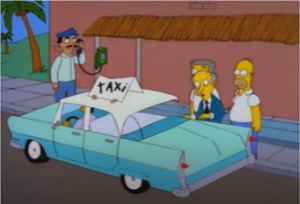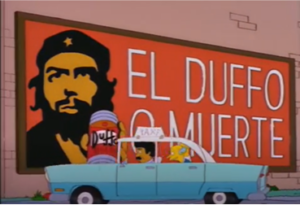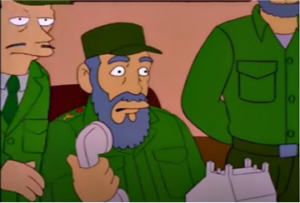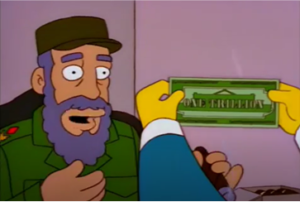What can two minutes of The Simpsons tell you about US perceptions of Cuba?
TV shows can tell us a lot about the relationships between different countries and societies. Placing a TV clip in the context of some basic knowledge about a country and its history can release a wealth of information that is otherwise easy to miss. Take this 2 minute clip of The Simpsons from 1998 in which Homer, Mr. Burns and Smithers travel to Cuba as an example.
 Upon entering Cuba, Homer is immediately asked to check the purpose of his visit – his three options sum up the American view of Cuba: business/pleasure i.e. as a holiday resort; smuggle cigars, i.e. as a haven of criminality, and assassinate Castro, i.e. as a troublesome political rival. But this clip shows that by the 1990s the USA was able to poke fun at its troubled relationship with Cuba, which included numerous failed attempts to kill Fidel Castro. This suggests that tensions were not as high as they had been during the Cold War.
Upon entering Cuba, Homer is immediately asked to check the purpose of his visit – his three options sum up the American view of Cuba: business/pleasure i.e. as a holiday resort; smuggle cigars, i.e. as a haven of criminality, and assassinate Castro, i.e. as a troublesome political rival. But this clip shows that by the 1990s the USA was able to poke fun at its troubled relationship with Cuba, which included numerous failed attempts to kill Fidel Castro. This suggests that tensions were not as high as they had been during the Cold War.

Mr. Burns, Smithers and Homer are picked up in a ramshackle taxi, as shown by the improvised sign on its roof, again a reference to Cuba’s poverty. Mr Burns, who fans of the show will know always references very old things, notes that the car is the ‘new Packard we’ve heard so much about’, meaning it is one of the old, pre-Cuban Revolution cars that are a regular sight in Cuba. Newer American cars are not available because of the American trade embargo.

They pass a billboard with Che Guevara on it, advertising Duff beer. This refers to how Che Guevara’s image has been repurposed and used for advertising. The slogan pokes fun at how his revolutionary image has been reappropriated into a brand “Duff or death”.

Castro announces that Cuba is bankrupt, and that Communism is over. This shows the American view of Communism as financially unworkable. He then calls the USA to concede defeat, noting that a street in San Francisco is named after him. Castro’s adviser whispers something that shocks him, this is a not-so-subtle reference to San Francisco’s status as a centre for America’s LGBTQ+ community, and to Castro’s harsh anti-homosexual policies.
 Castro proceeds to steal a trillion dollar bill from Mr. Burns (you need to watch the whole episode to understand why Mr. Burns has this ridiculous fictional note). This again highlights Cuba’s need for foreign currency, its poverty, and portrays Castro as sneaky and underhand. It is worth noting, that the US trade embargo, arguably the cause of many of these problems, is not referenced at all.
Castro proceeds to steal a trillion dollar bill from Mr. Burns (you need to watch the whole episode to understand why Mr. Burns has this ridiculous fictional note). This again highlights Cuba’s need for foreign currency, its poverty, and portrays Castro as sneaky and underhand. It is worth noting, that the US trade embargo, arguably the cause of many of these problems, is not referenced at all.
Not every TV show is quite as packed as these two minutes of The Simpsons. Nevertheless, using a video clip like this as a starter activity in lessons not only engages students with a source that is more fun than usual, but it is also a demonstration of how good source analysis skills enable you to draw useful inferences from virtually any source, even those that are unlikely to appear on an exam paper.






